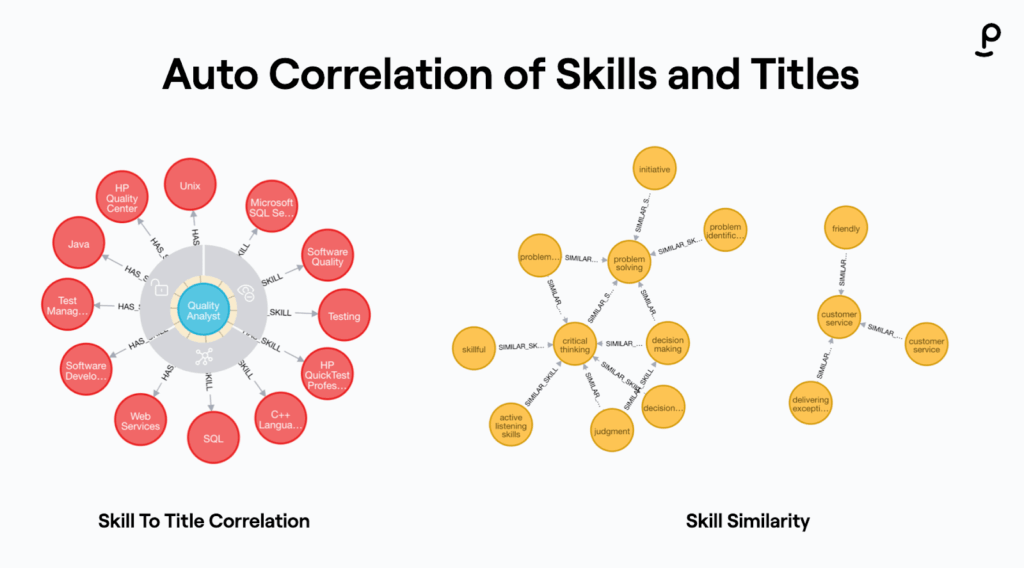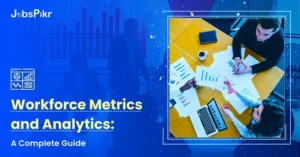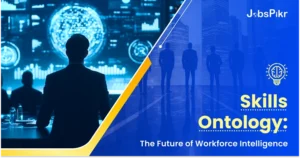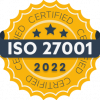- **TL;DR**
- Why Everyone’s Suddenly Talking About Skills Ontology
- What Is a Skills Ontology (And Why Does It Matter Now)?
- Build Your Workforce Intelligence with JobsPikr
- Skills Ontology vs. Skills Taxonomy: What’s the Difference?
- How Does a Skills Ontology Power Workforce Intelligence?
- What Is an Ontology-Based Skills Graph?
- Why Real-Time Job Data Is the Missing Ingredient
- How Organizations Use Skills Ontology Today
- The Workforce Graph Is Already Here
- Build Your Workforce Intelligence with JobsPikr
-
FAQs
- 1. What is skills ontology?
- 2. What is an example of a skills ontology?
- 3. What is the difference between skills ontology and taxonomy?
- 4. What is a skills taxonomy?
- 5. How does skills ontology improve workforce intelligence?
- 6. How is AI used in building and maintaining a skills ontology?
- 7. How does JobsPikr support skills ontology development?
**TL;DR**
Job titles used to tell us everything about work. Now, they tell us almost nothing. The same role means different things at different companies, and the same skill shows up in a dozen new jobs that didn’t exist five years ago. A skills ontology changes that.
Think of it as the connective tissue of modern workforce intelligence — mapping how skills relate, overlap, and evolve across industries. When companies combine this structure with real-time job market data, they stop reacting to talent gaps and start predicting them.
It’s not about replacing titles with buzzwords. It’s about building a living, breathing model of what work really looks like today, one that updates as fast as the market does.
Why Everyone’s Suddenly Talking About Skills Ontology
For decades, job descriptions have been our north star- HR teams built roles, recruiters matched résumés, and analysts forecasted workforce demand all around titles like “Marketing Manager” or “Software Engineer.” But the market doesn’t move in titles anymore. It moves in skills.
According to the World Economic Forum, 44% of workers’ core skills will change by 2027. That means almost half of what defines a role today will be outdated within just a few years. Titles stay static; skills don’t.
Enter skills ontology the structured mapping of workforce capabilities that helps organizations finally understand how skills relate, evolve, and cluster across jobs and industries.
When you connect this framework to real-world job data, something powerful happens. Workforce analytics stop being reactive dashboards and start becoming predictive systems. You can see which roles are converging, which skills are fading, and which capabilities your teams will need next quarter, not next decade.
That’s the foundation of workforce intelligence: knowing not just what people do, but what they can do next.
What Is a Skills Ontology (And Why Does It Matter Now)?

Image Source: Neobrain
Let’s start with the word itself — ontology. It sounds academic, but it’s really just a structured way of saying: “how things connect.” In the context of work, a skills ontology maps the relationships between job skills, roles, and functions — showing how one skill leads to another, or how clusters of skills define entire job families.
Think of it as the DNA of modern work. Every role is made up of smaller building blocks — technical skills, soft skills, and domain knowledge. Ontology connects those blocks, so you can trace how a “Marketing Analyst” overlaps with a “Growth Manager,” or how a “Data Engineer” evolves into an “ML Specialist.”
Why this matters right now is simple: job markets are changing too quickly for old frameworks to keep up. Traditional job taxonomies were built for static roles. But when one emerging technology can redefine a role overnight — like generative AI just did for content, coding, and design — static models collapse under their own weight.
A skills ontology solves that problem by being flexible, dynamic, and machine-readable. It allows workforce intelligence systems to continuously update how skills relate to each other based on real-world data, like millions of live job postings, training programs, and certifications.
The World Economic Forum’s 2023 Future of Jobs Report captures the urgency perfectly: “By 2027, 44% of workers’ core skills will change.”
That means almost half of what makes people qualified today won’t be enough tomorrow — unless organizations build systems that can actually see those shifts happening in real time.
When companies use skills ontology as the foundation of their workforce intelligence, they don’t just track roles — they track evolution. They can identify which skills are rising, which ones are declining, and which combinations create the next generation of jobs.
Build Your Workforce Intelligence with JobsPikr
Turn live job data into skill graphs, predictive insights, and smarter workforce decisions.
Skills Ontology vs. Skills Taxonomy: What’s the Difference?
Here’s a common mistake: people often use the terms “skills ontology” and “skills taxonomy” interchangeably. They’re not the same thing — not even close.
A skills taxonomy is a list. A skills ontology is a living network.
Taxonomies classify skills into buckets — like “Technical,” “Analytical,” or “Leadership.” They’re neat, hierarchical, and often static. They tell you what exists, but not how it’s connected.
An ontology, on the other hand, focuses on relationships. It maps how one skill influences or depends on another, how they evolve together, and how combinations of them define entire roles.
| Aspect | Skills Taxonomy | Skills Ontology |
| Core Definition | A structured list or hierarchy of skills organized by category or level. | A connected network showing how skills relate, overlap, and evolve together. |
| Purpose | To classify and group existing skills. | To understand relationships between skills and predict emerging ones. |
| Structure | Linear and hierarchical — “Parent → Child” model (e.g., Digital Skills → Programming → Python). | Non-linear and relational — “Skill ↔ Skill” model (e.g., Python ↔ Data Analysis ↔ Machine Learning). |
| Update Frequency | Periodic, often manually updated. | Dynamic, continuously updated using real-time job data and AI. |
| Use Case | Good for creating standardized skill libraries or course catalogs. | Ideal for powering workforce intelligence, job matching, and skill forecasting. |
| Scalability | Limited — struggles with fast-changing or hybrid roles. | High — adapts to new skills, emerging roles, and cross-domain shifts. |
| Example in Action | Lists “Data Visualization” under “Analytical Skills.” | Connects “Data Visualization” to “Power BI,” “Storytelling,” and “Dashboard Design,” mapping its real-world use. |
Here’s an analogy:
If a skills taxonomy is a dictionary, a skills ontology is Google Maps. A dictionary tells you the meaning of each word. Google Maps shows you how to get from one place to another — and even which routes are changing in real time.
The same logic applies to workforce data. A taxonomy might tell you “Python” is a programming language. An ontology will show you that “Python” connects to “Data Analysis,” which connects to “Business Intelligence,” which ties to roles like “Data Scientist” or “Machine Learning Engineer.” That’s the kind of context that lets organizations plan training, reskilling, and hiring intelligently.
This is where workforce intelligence comes alive. With ontology-driven systems, companies can detect when a skill like “Prompt Engineering” starts clustering with “NLP” and “Data Annotation.” That’s not just a job posting trend — it’s an early signal of how new job families are forming.
And because ontology frameworks are machine-readable, they’re ideal for automation and AI integration. HR tech platforms can feed them into AI models for job matching, candidate discovery, and learning path recommendations — functions that were nearly impossible with rigid taxonomies.
It’s not just semantics. It’s the difference between describing the job market and understanding it.
The Skills Ontology Starter Kit: Building a Smarter Workforce Graph
How Does a Skills Ontology Power Workforce Intelligence?
Workforce intelligence is only as good as the data underneath it. For years, HR systems tried to make sense of roles using static categories like job titles or departments. That approach worked when jobs stayed stable for decades. Today, a role can evolve faster than an HR database can refresh.
That’s where skills ontology becomes the engine of workforce intelligence. It transforms how organizations see their talent — from rigid boxes to living networks.
Here’s how it works in practice:
1. It connects fragmented data
Most workforce data sits in silos — résumés, learning platforms, job postings, performance systems. A skills ontology unifies them by creating a common skills language. “Data Visualization,” “Power BI,” and “Dashboarding” stop being three separate fields in different systems and become one connected node in a larger network.
2. It reveals hidden relationships
Traditional analytics might tell you how many data analysts you have. An ontology shows which analysts are already 60% aligned with machine learning engineer roles — because it recognizes shared skills like Python, data cleaning, and feature engineering. That’s what lets HR teams design internal mobility programs based on adjacency rather than job title.
3. It enables predictive insights
When your ontology is connected to live job market data, it starts showing patterns before they hit your workforce. If postings that require “AI prompt engineering” are rising 120% in your industry, your ontology surfaces related skills like NLP and model fine-tuning — helping you anticipate what to train for next.
4. It powers AI-driven workforce decisions
Ontologies feed machine learning models that can automatically recommend learning paths, identify skill clusters, or forecast which roles will emerge next. In other words, they make workforce intelligence actually intelligent.
The result is a complete shift from reactive HR to a proactive strategy. Instead of waiting for a skills gap to appear, you see it forming months in advance.
The 2025 update projects 39 % of core skills will change by 2030 — still a major shift, though slightly slower than early forecasts.
That’s not a coincidence — it’s what happens when you replace lagging indicators (like job openings or turnover) with leading ones (like emerging skill clusters).
What Is an Ontology-Based Skills Graph?

Image Source: Phenom
Imagine your workforce data not as a spreadsheet, but as a living map. Every skill is a point on that map, connected to other skills through real-world relationships — “requires,” “complements,” “evolves into,” “commonly co-occurs with.”
That’s what a skills graph built on ontology looks like.
How It Works
In a skills ontology, every skill becomes a node, and every relationship becomes an edge. For example: “Python” connects to “Data Analysis,” which connects to “Business Intelligence,” which leads to roles like “Data Scientist.”
Now imagine this not as theory, but as something updated daily by millions of job postings. Every time a new job ad links Python to Generative AI or Model Deployment, those connections strengthen — showing that the market is redefining how these skills relate.
That’s the difference between a static competency framework and an ontology-based skills graph: one gets outdated, the other evolves with reality.
Why This Graph Matters
1. It visualizes how work evolves
The graph doesn’t just show what skills are trending — it shows how they’re converging. For example, “marketing analytics” is no longer separate from “data storytelling.” These overlaps are visible in an ontology graph long before job titles change.
2. It supports smarter hiring and learning systems
AI-powered recruitment tools can use ontology-based graphs to recommend adjacent skills. If someone is strong in SQL and Tableau, the system might suggest machine learning fundamentals as the next logical step.
Similarly, learning platforms can design personalized paths that mirror how skills naturally connect in the market.
3. It helps predict emerging job families
The graph reveals new intersections — say “Generative AI” + “Prompt Design” + “UX Writing.” That’s not a random cluster; it’s a preview of a new role forming in real time.
The Role of Real-Time Job Data
Without real-time updates, even the best ontology becomes stale. That’s where job market analytics come in. They constantly feed new data into the graph — adjusting skill relationships, adding emerging terms, and retiring obsolete ones.
At JobsPikr, we see this happen across millions of postings every month. Skills like “data labeling” once sat in isolation; now they’re deeply connected to “AI training data” and “model validation.” That’s not just a data trend — it’s a shift in how the workforce itself operates.
In essence, an ontology-based skills graph gives companies a lens to see work as a network — not a hierarchy. And when your workforce strategy mirrors that network, you don’t just keep up with change; you lead it.
Why Real-Time Job Data Is the Missing Ingredient
Even the smartest skills ontology falls apart if it runs on stale data. The reason is simple: skills evolve at the speed of technology, not HR updates.
Most organizations build their competency frameworks once, lock them into an LMS, and revisit them every two or three years. By then, half the job market has already moved on. That’s why real-time job data is the single most powerful input for maintaining an accurate, adaptive ontology.
Here’s what it changes:
1. It keeps skill relationships alive
When a new job posting links “GenAI” with “Marketing Automation,” that connection doesn’t exist in last year’s taxonomy. But it shows up immediately in a live ontology fed by job data. Over thousands of postings, those connections reveal how new job archetypes are forming — like Prompt-Driven Content Strategist or AI-Marketing Analyst.
2. It identifies emerging skills before they go mainstream
Real-time data highlights the early indicators — the niche certifications, experimental tools, or hybrid titles that hint at a shift. For example, “RAG Engineer” was an obscure phrase in early 2024; by mid-2025, it appeared in thousands of postings. A static framework would never have caught that signal.
3. It exposes regional and industry patterns
A skill might surge in one market long before another. Job data shows where demand starts, how it spreads, and when it peaks. Workforce planners can use these insights to decide where to hire, train, or outsource based on geography and industry cycles.
4. It connects external demand to internal supply
The best skill intelligence doesn’t just show what the world needs — it shows how your current workforce stacks up against it. By linking internal HR data to external job market analytics, you can see exactly which capabilities are future-proof and which need development.
This is where JobsPikr becomes the real differentiator.
Our datasets pull from millions of live postings, normalize the skill language, and feed those insights into ontology-ready structures. The result isn’t just a skills list — it’s a living model that updates itself every day as the market shifts.
Companies using this approach move faster. They update job architectures quarterly instead of annually. They retrain teams before competitors realize there’s a gap. And they base every workforce decision on evidence, not assumptions.
In short, real-time job data turns a static skills ontology into true workforce intelligence—a system that evolves as quickly as the people it represents.
The Skills Ontology Starter Kit: Building a Smarter Workforce Graph
How Organizations Use Skills Ontology Today
For most companies, “skills ontology” sounds like something only research labs or large HR tech platforms would care about. But it’s already reshaping how leading organizations plan, hire, and develop their workforces. Let’s look at where it’s making the biggest impact right now.
1. Workforce Planning and Strategic Forecasting
Traditional workforce planning starts with headcount — how many people you have in each role. A skills ontology flips that lens. Instead of counting roles, it counts capabilities.
When companies map their internal workforce skills onto an ontology, they can see overlaps, redundancies, and gaps. For example, you might realize that 40% of your “Data Analysts” already have 70% of the skills required for “Machine Learning Engineer” roles. That insight lets HR and business leaders forecast transitions and create reskilling programs instead of scrambling to hire externally.
Consulting firms and global enterprises use this model to simulate future scenarios — for instance, “What if automation reduces our reporting workload by 30%? Which adjacent skills will we need to retrain analysts for instead?” That’s not a headcount plan. That’s strategic foresight.
2. Learning and Development Alignment
L&D teams often struggle with relevance. Courses get built around old frameworks while the job market keeps changing. A skills ontology, powered by job market analytics, solves that.
When you know how the outside world is evolving, you can align internal training with external demand. Suppose the ontology reveals that “data storytelling” now frequently co-occurs with “Power BI” and “marketing analytics” in job postings. L&D can design a training path that builds exactly that skill cluster.
That’s how companies stop guessing what to teach and start aligning learning with live demand — creating a measurable link between training investment and employability.
3. Recruitment and Job Matching
Recruiters today face a simple but expensive problem: job titles are inconsistent. One company’s “Product Analyst” might be another’s “Insights Manager.” A skills ontology fixes that confusion.
By breaking down each role into its constituent skills and relationships, AI-based hiring tools can match candidates more accurately, even when titles differ. For example, a candidate skilled in SQL, Tableau, and stakeholder reporting may not have “Data Analyst” in their title, but ontology-based systems can still identify them as a 90% match.
This improves candidate discovery, reduces bias, and increases speed to hire, because the model understands what work means, not just what it’s called.
4. Compensation Benchmarking and Career Pathing
When your skill network connects to real-time job data, you can go beyond generic salary bands.
You can compare pay based on actual capabilities — not job titles. For instance, two “UX Designers” might command different market rates because one also has “prompt design” or “AI-driven prototyping” skills.
Ontology-based frameworks make those distinctions visible, letting compensation teams benchmark accurately and helping employees see transparent, skill-based career paths.
5. Organizational Resilience and Redeployment
During restructuring or automation cycles, companies with ontology-based workforce models can act fast. Instead of laying off by title, they identify which transferable skills can be redeployed internally. This reduces severance costs and preserves institutional knowledge.
In uncertain markets, agility isn’t about who you hire — it’s about who you can reskill.
The Workforce Graph Is Already Here
Every hiring decision, every training program, every compensation benchmark, they all depend on understanding skills. The challenge isn’t collecting data; it’s connecting it. That’s what a skills ontology makes possible.
It gives organizations the power to see the workforce as a living network, one that adapts, learns, and predicts. Paired with real-time job market analytics, it turns fragmented data into workforce intelligence: a system that doesn’t just describe your talent, but helps you evolve it.
As industries reshape themselves around AI, automation, and continuous learning, one truth stands out: companies that understand their skills will lead the ones that only understand their roles.
The future of work isn’t about titles. It’s about connections.
Build Your Workforce Intelligence with JobsPikr
Turn live job data into skill graphs, predictive insights, and smarter workforce decisions.
FAQs
1. What is skills ontology?
A skills ontology is a structured system that maps how different skills connect, overlap, and evolve. Instead of treating each skill as an isolated item, it shows relationships — like how “Python” connects to “data analysis,” which links to “machine learning.” This interconnected model helps organizations understand not just what skills people have, but how those skills fit into broader job and industry trends.
2. What is an example of a skills ontology?
A practical example is the ESCO framework used in Europe. It links skills to occupations and shows how they sit together in the real world. Another good mental picture: the way “SQL” often appears alongside “Tableau” and “stakeholder reporting” in job ads — that pattern is exactly what an ontology captures and formalizes.
3. What is the difference between skills ontology and taxonomy?
A taxonomy is a tidy list. It tells you that “Data Visualization” is a type of analytical skill. An ontology goes further: it shows that “Data Visualization” often pairs with “Power BI,” “storytelling,” and “dashboard design,” and that those combinations feed roles like “Analytics Lead.” One classifies; the other explains how things relate and move.
4. What is a skills taxonomy?
It’s a structured catalogue of skills, grouped into families and levels. Think “Programming → Python → Pandas.” This is useful for organizing internal libraries and job frameworks. Its limit: it doesn’t show you which skills commonly travel together or how new ones emerge. That’s where ontology takes over.
5. How does skills ontology improve workforce intelligence?
It gives you context. Instead of seeing a pile of skills, you see pathways. You can spot that many of your analysts are one or two steps away from machine learning work, or that a rising cluster around “marketing automation + GenAI + experimentation” is becoming a real role. Planning, training, and hiring become based on evidence, not guesswork.
6. How is AI used in building and maintaining a skills ontology?
AI reads the market at scale. It scans job ads, course outlines, and profiles to find which skills show up together, which ones are fading, and which are new. Those signals update the connections in the ontology so it reflects how work is shifting right now, not how it looked two years ago.
7. How does JobsPikr support skills ontology development?
JobsPikr supplies the live job data that keeps the model honest. Our feeds show which skills employers are actually asking for, how those skills cluster by role and location, and where demand is heading. That stream plugs into your ontology so your maps of work match the market you’re hiring in.




